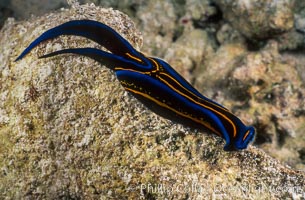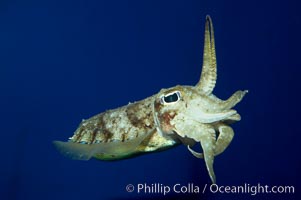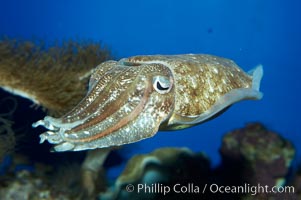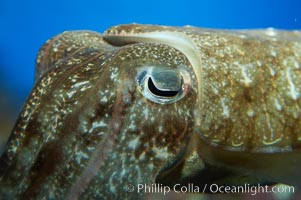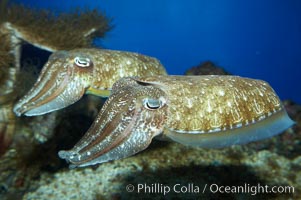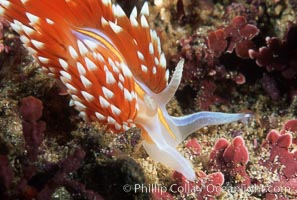
Nudibranch on calcareous coralline algae.
Species: Opalescent nudibranch, Hermissenda crassicornis
Location: Monterey, California
Image ID: 05285
Species: Opalescent nudibranch, Hermissenda crassicornis
Location: Monterey, California
Image ID: 05285
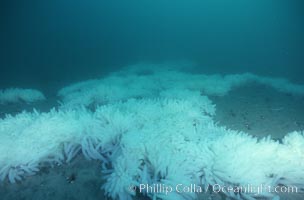
Squid egg clusters on sand.
Species: Common squid, Loligo opalescens
Location: La Jolla, California
Image ID: 05407
Species: Common squid, Loligo opalescens
Location: La Jolla, California
Image ID: 05407
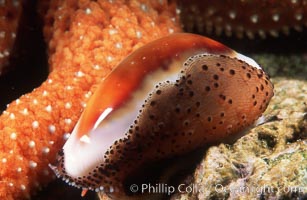
Chestnut cowrie with mantle extended.
Species: Chestnut cowrie, Date cowrie, Cypraea spadicea
Location: San Miguel Island, California
Image ID: 01035
Species: Chestnut cowrie, Date cowrie, Cypraea spadicea
Location: San Miguel Island, California
Image ID: 01035
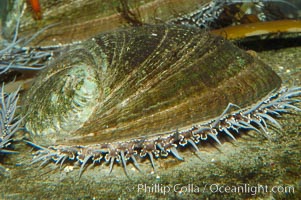
Green abalone with mantle fringe visible extending outside shell.
Species: Green abalone, Haliotis fulgens
Image ID: 09242
Species: Green abalone, Haliotis fulgens
Image ID: 09242
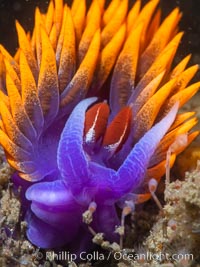
Spanish shawl nudibranch, Flabellinopsis iodinea, San Diego.
Species: Spanish Shawl Nudibranch, Flabellinopsis iodinea
Location: San Diego, California
Image ID: 37291
Species: Spanish Shawl Nudibranch, Flabellinopsis iodinea
Location: San Diego, California
Image ID: 37291
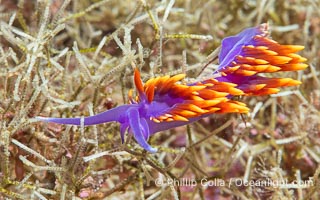
Spanish shawl nudibranch, Flabellinopsis iodinea, Midriff Islands, Sea of Cortez.
Species: Spanish Shawl Nudibranch, Flabellinopsis iodinea
Location: Isla Angel de la Guarda, Baja California, Mexico
Image ID: 40321
Species: Spanish Shawl Nudibranch, Flabellinopsis iodinea
Location: Isla Angel de la Guarda, Baja California, Mexico
Image ID: 40321
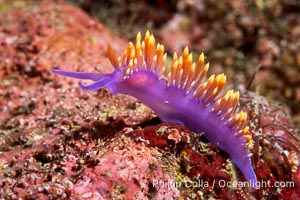
Spanish shawl nudibranch, Flabellinopsis iodinea, Midriff Islands, Sea of Cortez.
Species: Spanish Shawl Nudibranch, Flabellinopsis iodinea
Location: Isla Angel de la Guarda, Baja California, Mexico
Image ID: 40322
Species: Spanish Shawl Nudibranch, Flabellinopsis iodinea
Location: Isla Angel de la Guarda, Baja California, Mexico
Image ID: 40322
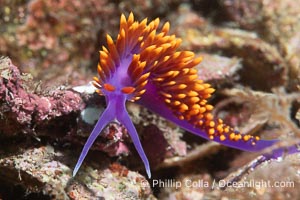
Spanish shawl nudibranch, Flabellinopsis iodinea, Midriff Islands, Sea of Cortez.
Species: Spanish Shawl Nudibranch, Flabellinopsis iodinea
Location: Isla Angel de la Guarda, Baja California, Mexico
Image ID: 40323
Species: Spanish Shawl Nudibranch, Flabellinopsis iodinea
Location: Isla Angel de la Guarda, Baja California, Mexico
Image ID: 40323
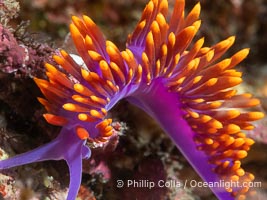
Spanish shawl nudibranch, Flabellinopsis iodinea, Midriff Islands, Sea of Cortez.
Species: Spanish Shawl Nudibranch, Flabellinopsis iodinea
Location: Isla Angel de la Guarda, Baja California, Mexico
Image ID: 40324
Species: Spanish Shawl Nudibranch, Flabellinopsis iodinea
Location: Isla Angel de la Guarda, Baja California, Mexico
Image ID: 40324
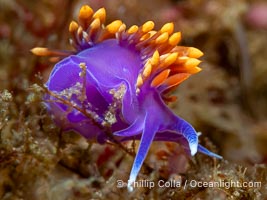
Spanish shawl nudibranch, Flabellinopsis iodinea, Midriff Islands, Sea of Cortez.
Species: Spanish Shawl Nudibranch, Flabellinopsis iodinea
Location: Islas San Lorenzo, Baja California, Mexico
Image ID: 40464
Species: Spanish Shawl Nudibranch, Flabellinopsis iodinea
Location: Islas San Lorenzo, Baja California, Mexico
Image ID: 40464
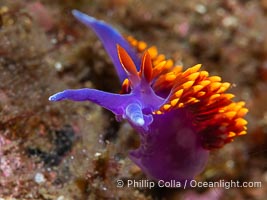
Spanish shawl nudibranch, Flabellinopsis iodinea, Midriff Islands, Sea of Cortez.
Species: Spanish Shawl Nudibranch, Flabellinopsis iodinea
Location: Islas San Lorenzo, Baja California, Mexico
Image ID: 40468
Species: Spanish Shawl Nudibranch, Flabellinopsis iodinea
Location: Islas San Lorenzo, Baja California, Mexico
Image ID: 40468
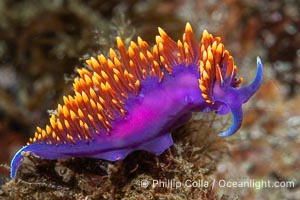
Spanish shawl nudibranch, Flabellinopsis iodinea, Midriff Islands, Sea of Cortez.
Species: Spanish Shawl Nudibranch, Flabellinopsis iodinea
Location: Islas San Lorenzo, Baja California, Mexico
Image ID: 40476
Species: Spanish Shawl Nudibranch, Flabellinopsis iodinea
Location: Islas San Lorenzo, Baja California, Mexico
Image ID: 40476
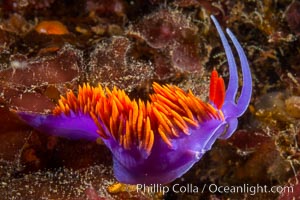
Spanish shawl nudibranch.
Species: Spanish Shawl Nudibranch, Flabellinopsis iodinea
Location: San Diego, California
Image ID: 34200
Species: Spanish Shawl Nudibranch, Flabellinopsis iodinea
Location: San Diego, California
Image ID: 34200
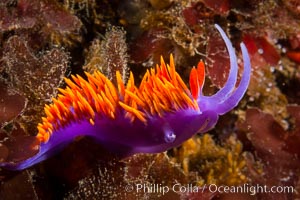
Spanish shawl nudibranch.
Species: Spanish Shawl Nudibranch, Flabellinopsis iodinea
Location: San Diego, California
Image ID: 34201
Species: Spanish Shawl Nudibranch, Flabellinopsis iodinea
Location: San Diego, California
Image ID: 34201
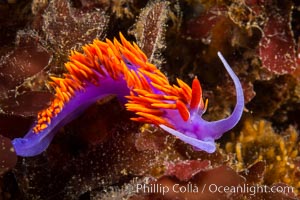
Spanish shawl nudibranch.
Species: Spanish Shawl Nudibranch, Flabellinopsis iodinea
Location: San Diego, California
Image ID: 34202
Species: Spanish Shawl Nudibranch, Flabellinopsis iodinea
Location: San Diego, California
Image ID: 34202
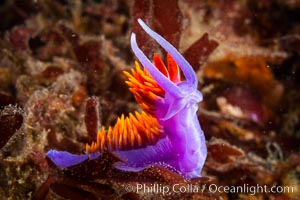
Spanish shawl nudibranch.
Species: Spanish Shawl Nudibranch, Flabellinopsis iodinea
Location: San Diego, California
Image ID: 34203
Species: Spanish Shawl Nudibranch, Flabellinopsis iodinea
Location: San Diego, California
Image ID: 34203
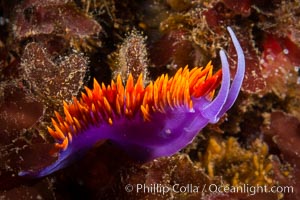
Spanish shawl nudibranch.
Species: Spanish Shawl Nudibranch, Flabellinopsis iodinea
Location: San Diego, California
Image ID: 34204
Species: Spanish Shawl Nudibranch, Flabellinopsis iodinea
Location: San Diego, California
Image ID: 34204
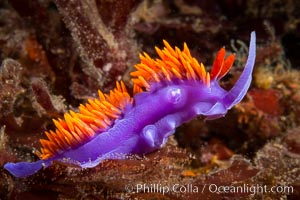
Spanish shawl nudibranch.
Species: Spanish Shawl Nudibranch, Flabellinopsis iodinea
Location: San Diego, California
Image ID: 34205
Species: Spanish Shawl Nudibranch, Flabellinopsis iodinea
Location: San Diego, California
Image ID: 34205
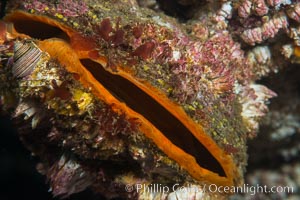
Crassadoma gigantea, Scallop, Hornby Island, Canada.
Location: Hornby Island, British Columbia, Canada
Image ID: 32823
Location: Hornby Island, British Columbia, Canada
Image ID: 32823
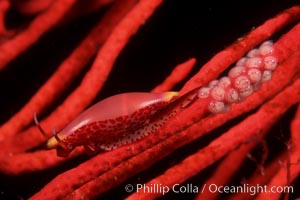
Simnia and egg cluster on red gorgonian.
Species: Red gorgonian, Simnia, Delonovolva aequalis, Leptogorgia chilensis, Lophogorgia chilensis
Location: Anacapa Island, California
Image ID: 01983
Species: Red gorgonian, Simnia, Delonovolva aequalis, Leptogorgia chilensis, Lophogorgia chilensis
Location: Anacapa Island, California
Image ID: 01983
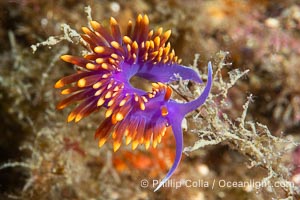
Spanish shawl nudibranch, Flabellinopsis iodinea, Midriff Islands, Sea of Cortez.
Species: Spanish Shawl Nudibranch, Flabellinopsis iodinea
Location: Isla Angel de la Guarda, Baja California, Mexico
Image ID: 40316
Species: Spanish Shawl Nudibranch, Flabellinopsis iodinea
Location: Isla Angel de la Guarda, Baja California, Mexico
Image ID: 40316
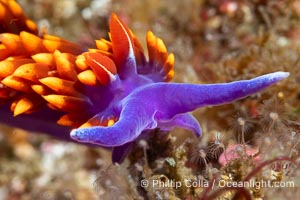
Spanish shawl nudibranch, Flabellinopsis iodinea, Midriff Islands, Sea of Cortez.
Species: Spanish Shawl Nudibranch, Flabellinopsis iodinea
Location: Islas San Lorenzo, Baja California, Mexico
Image ID: 40465
Species: Spanish Shawl Nudibranch, Flabellinopsis iodinea
Location: Islas San Lorenzo, Baja California, Mexico
Image ID: 40465
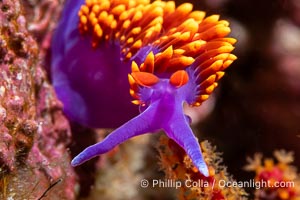
Spanish shawl nudibranch, Flabellinopsis iodinea, Midriff Islands, Sea of Cortez.
Species: Spanish Shawl Nudibranch, Flabellinopsis iodinea
Location: Islas San Lorenzo, Baja California, Mexico
Image ID: 40472
Species: Spanish Shawl Nudibranch, Flabellinopsis iodinea
Location: Islas San Lorenzo, Baja California, Mexico
Image ID: 40472
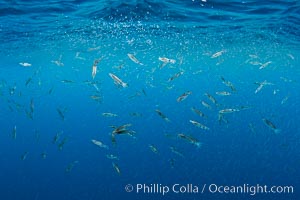
Krill and squid school at the ocean surface, moments before blue and fin whales rise to the surface to feed. The krill is likely Euphausia pacifica, the squid are likely Loligo opalescens. A thin cloud of pink krill gathers at the ocean surface, where it is likely to be preyed upon by sharks, fish, birds and whales.
Species: Common squid, Krill, Euphausia pacifica, Loligo opalescens
Location: San Diego, California
Image ID: 27152
Species: Common squid, Krill, Euphausia pacifica, Loligo opalescens
Location: San Diego, California
Image ID: 27152
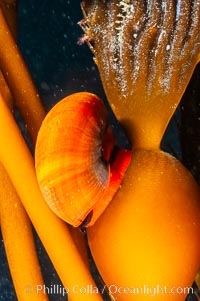
Norris topsnail (aka, kelp snail), clings to a kelp pneumatocyst (bubble) at the base of a stipe/blade, midway in the water column.
Species: Norris' top snail, Macrocystis pyrifera, Norrisia norrisi
Location: San Nicholas Island, California
Image ID: 10214
Species: Norris' top snail, Macrocystis pyrifera, Norrisia norrisi
Location: San Nicholas Island, California
Image ID: 10214
